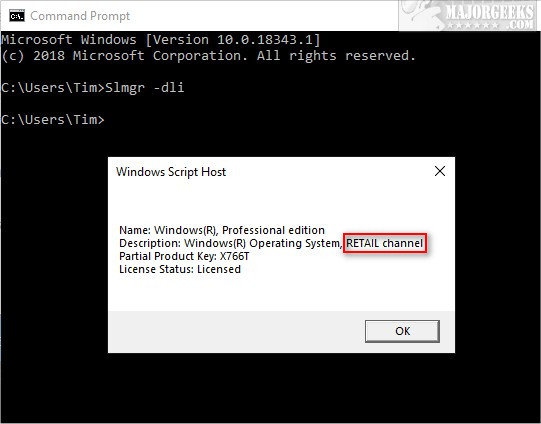How to Check if Your Windows License is Retail, OEM, or Volume
By Timothy Tibbettson 06/15/2023 |
There are three types of Windows licenses: Retail, OEM, or Volume. If you're wondering what the difference is or which version you have, here's all you need to know.
Finding out which type you have is easy to do, so let's get that out of the way.
Open a Command Prompt or PowerShell.
There are a few possible commands depending on whether you use PowerShell, Command Prompt, or Windows Terminal:
slmgr.vbs /dlv
Slmgr –dli
Slmgr /dli
Wait a few seconds for the Windows Script Manager to appear and tell you which license type you have.

You should see what edition you have (Home, Pro), and the second line will tell you if you have Retail, OEM, or Volume. A partial product key will also be displayed and whether it is licensed.
That's it!
So, what are the differences between Retail, OEM, or Volume?
Retail
A retail license means you purchased Windows either online or at a store, and you should have a physical copy. Retail Windows can be transferred and activated to another computer but only assigned to one computer at any time.
OEM
OEM or Original Equipment Manufacturer means your copy of Windows came installed on your computer and is licensed only to that computer for its lifespan. Nowadays, most of these licenses are embedded in the BIOS or UEFI firmware. OEM licenses are standard with brand-name computers, including Dell, Hewlett, Packard, Compaq, etc. One exception would be OEM-SLP. This is preinstalled; no activation required key. You can not install Windows using this key, but you can recover from a preinstalled partition on your computer. Check with your manufacturer on how to do that.
Volume
Volume licenses are often purchased in bulk by large companies, educational institutes, or the government. There's a good chance that these keys can be installed on other computers, but bulk sales usually have a limit, and when that limit is exceeded, the product key is no longer valid on another computer.
Similar:
Retrieve Your Windows and Office Product Keys with These Free Apps
How-To Retrieve an Embedded Windows Key
How to Check if Your Windows License is Retail, OEM, or Volume
How-to Transfer Your Windows 10 & 11 License to Another Computer
Will Windows 10 or 11 Receive Windows Updates if It's Not Activated?
Can I Have Multiple Windows 10 & 11 or Microsoft Office Keys One One Account?
comments powered by Disqus
Finding out which type you have is easy to do, so let's get that out of the way.
Open a Command Prompt or PowerShell.
There are a few possible commands depending on whether you use PowerShell, Command Prompt, or Windows Terminal:
slmgr.vbs /dlv
Slmgr –dli
Slmgr /dli
Wait a few seconds for the Windows Script Manager to appear and tell you which license type you have.

You should see what edition you have (Home, Pro), and the second line will tell you if you have Retail, OEM, or Volume. A partial product key will also be displayed and whether it is licensed.
That's it!
So, what are the differences between Retail, OEM, or Volume?
Retail
A retail license means you purchased Windows either online or at a store, and you should have a physical copy. Retail Windows can be transferred and activated to another computer but only assigned to one computer at any time.
OEM
OEM or Original Equipment Manufacturer means your copy of Windows came installed on your computer and is licensed only to that computer for its lifespan. Nowadays, most of these licenses are embedded in the BIOS or UEFI firmware. OEM licenses are standard with brand-name computers, including Dell, Hewlett, Packard, Compaq, etc. One exception would be OEM-SLP. This is preinstalled; no activation required key. You can not install Windows using this key, but you can recover from a preinstalled partition on your computer. Check with your manufacturer on how to do that.
Volume
Volume licenses are often purchased in bulk by large companies, educational institutes, or the government. There's a good chance that these keys can be installed on other computers, but bulk sales usually have a limit, and when that limit is exceeded, the product key is no longer valid on another computer.
Similar:
comments powered by Disqus






